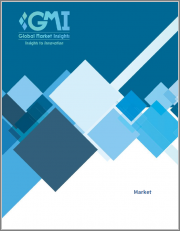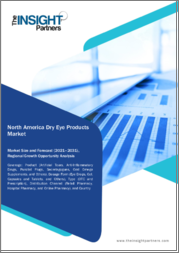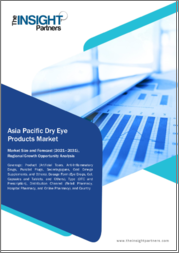
|
시장보고서
상품코드
1354295
세계의 안구건조증 시장 규모 : 제품별, 질환 유형별, 유통 채널별, 예측(2023-2032년)Dry Eye Disease Market Size - By Product, By Disease Type, By Distribution Channel, & Forecast, 2023 - 2032 |
||||||
세계 안구건조증 시장은 2023년부터 2032년까지 연평균 복합 성장률(CAGR) 7.4%를 나타낼 것으로 보입니다.
생활습관의 변화, 스크린 사용 시간 증가, 환경적 요인이 안구건조증 유병률 증가에 기여하고 있으며, NCBI에 따르면 안구건조증(DED)은 매우 흔한 안과 질환으로 세계 많은 사람들에게 영향을 미치고 있으며, 지역에 따라 유병률은 5%에서 50%까지 다양합니다. 또한, 세계적으로 고령화 인구가 증가하고 있는 것도 시장을 뒷받침하고 있습니다.
안구건조증 시장 전망은 지속적인 연구 개발 노력으로 혁신적인 치료법과 제품이 개발되고 있기 때문입니다. 또한, 의료 전문가와 환자들 사이에서 DED에 대한 인식이 높아짐에 따라 조기 진단과 조기 치료가 촉진되어 시장 성장을 더욱 촉진하고 있습니다.
전체 안구건조증 시장은 제품, 질병 유형, 유통 채널 및 지역별로 분류됩니다.
코르티코스테로이드 외용제 부문은 2023년부터 2032년까지 8.4%의 연평균 복합 성장률(CAGR)을 나타낼 것으로 예상됩니다. 이러한 약물은 DED와 관련된 염증을 효과적으로 완화하고 환자에게 필요한 편안함을 제공합니다. 고령화 사회의 확대와 함께 DED와 그 관리 옵션에 대한 인식이 높아짐에 따라 DED 시장에서 코르티코스테로이드 외용제에 대한 수요는 계속 증가할 것으로 보입니다. 이 질환의 관리에서 코르티코스테로이드의 역할은 안구건조증 시장의 수익에 기여하고 있습니다.
질병 유형별로는 눈물 감소성 안구건조증(ADDE) 증후군이 2023년부터 2032년까지 8%의 연평균 복합 성장률(CAGR)을 나타낼 것으로 보입니다. 이 DED의 하위 유형은 눈물 분비 감소로 인해 심각한 불편함을 유발할 수 있으며, ADDE 환자들은 증상을 효과적으로 관리하기 위해 인공눈물이나 처방약과 같은 전문적 치료에 의존하는 경우가 많습니다. 표적 치료제에 대한 수요는 지속적으로 증가하고 있습니다.
유럽의 안구건조증 시장은 2023년부터 2032년까지 7.2%의 연평균 복합 성장률(CAGR)을 나타낼 것으로 예상됩니다. 고령화 사회는 스크린 사용 시간 증가 및 기타 환경적 요인과 함께 DED의 유병률을 높이고 있으며, Eurostat에 따르면 2022년에는 EU 인구의 5분의 1 이상(21.1%)이 65세 이상이 될 것으로 예상됩니다. 또한, 의료에 대한 관심 증가와 DED 치료 및 진단 방법의 발전이 시장 확대의 원동력이 되고 있습니다. 인식이 높아짐에 따라 환자들은 효과적인 해결책을 찾고 있으며, 유럽 전역에서 DED 관련 제품 및 서비스에 대한 수요가 증가하고 있습니다.
목차
제1장 조사 방법과 조사 범위
제2장 주요 요약
제3장 안구건조증 업계 인사이트
- 생태계 분석
- 업계에 대한 영향요인
- 성장 촉진요인
- 업계의 잠재적 리스크&과제
- 성장 가능성 분석
- COVID-19의 영향 분석
- 규제 상황
- 주요 시장 동향
- 상환 시나리오
- 기술 전망
- 향후 시장 동향
- 밸류체인 분석
- 갭 분석
- Porter's Five Forces 분석
- PESTEL 분석
제4장 경쟁 구도
- 서론
- 기업 매트릭스 분석
- 세계 기업의 시장 점유율 분석
- 벤더 매트릭스 분석
- 경쟁 포지셔닝 매트릭스
- 전략 대시보드
제5장 안구건조증 시장 규모와 예측 : 제품별
- 주요 동향 : 제품별
- 시클로스포린
- 코르티코스테로이드 외용약
- 인공눈물
- 우점 플러그
- 제거 가능
- 용해 가능
- 경구 오메가 보충제
- 기타
제6장 안구건조증 시장 규모와 예측 : 질환 유형별
- 주요 동향 : 질환 유형별
- 증발성 안구 건조증
- 수성 결핍성 안구 건조증
제7장 안구건조증 시장 규모와 예측 : 유통 채널별
- 주요 동향 : 유통 채널별
- 병원 약국
- 소매 약국
- 온라인 약국
제8장 안구건조증 시장 규모와 예측 : 지역별
- 주요 동향 : 지역별
- 북미
- 미국
- 캐나다
- 유럽
- 독일
- 영국
- 프랑스
- 스페인
- 이탈리아
- 폴란드
- 스웨덴
- 네덜란드
- 아시아태평양
- 일본
- 중국
- 인도
- 호주
- 한국
- 태국
- 인도네시아
- 필리핀
- 라틴아메리카
- 브라질
- 멕시코
- 아르헨티나
- 콜롬비아
- 칠레
- 페루
- 중동 및 아프리카(MEA)
- 남아프리카공화국
- 사우디아라비아
- 아랍에미리트(UAE)
- 이스라엘
- 이집트
- 터키
제9장 기업 개요
- AbbVie, Inc.
- AFT Pharmaceuticals
- Alcon
- Bausch & Lomb
- Johnson & Johnson Services, Inc.
- Novartis AG
- OASIS Medical
- Otsuka Pharmaceutical Co., Ltd.
- Oyster Point Pharma, Inc.
- Santen Pharmaceutical Co., Ltd.
- Sentiss Pharma Pvt. Ltd
- Sun Pharmaceutical Industries Ltd.
- Thea Pharmaceuticals Ltd.
- VISUfarma
- Takeda Pharmaceutical Company Ltd.
Global Dry Eye Disease Market will witness 7.4% CAGR between 2023 and 2032. Changing lifestyles, increased screen time, and environmental factors contribute to a rising prevalence of DED. According to NCBI, dry eye disease (DED) is a highly common eye condition that impacts a substantial number of individuals worldwide, with its prevalence varying from 5% to 50% across different geographic regions. Additionally, a rising number of aging populations worldwide also supports the market.
The dry eye disease market outlook benefits from continuous research and development efforts, resulting in innovative treatments and products. Additionally, the growing awareness of DED among healthcare professionals and patients alike fosters early diagnosis and treatment, further stimulating market growth.
The overall Dry Eye Disease Market is classified based on product, disease type, and region.
The topical corticosteroids segment will witness an 8.4% CAGR from 2023 to 2032. These medications offer effective relief from inflammation associated with DED, providing much-needed comfort to patients. As awareness of DED and its management options increases, coupled with the expansion of aging populations, the demand for topical corticosteroids in the DED market will continue to rise. Their role in managing the condition contributes to the dry eye disease market revenue.
Regarding the disease type, the aqueous deficient dry eye syndrome segment will observe 8% CAGR from 2023 to 2032. This subtype of DED results from reduced tear production and can cause severe discomfort. Patients with ADDE often rely on specialized treatments, such as artificial tears and prescription medications, to manage their conditions effectively. As awareness and diagnosis of ADDE increase, the demand for targeted therapies within the DED market continues to grow.
Europe dry eye disease market will showcase 7.2% CAGR from 2023 to 2032. An aging population, in tandem with increased screen time and other environmental factors, elevates DED prevalence. According to Eurostat, in 2022, more than one-fifth (21.1 %) of the EU population was aged 65 and over. Furthermore, a growing focus on healthcare and advancements in DED treatments and diagnostics drive market expansion. As awareness grows, patients seek effective solutions, bolstering demand for DED-related products and services across Europe.
Table of Contents
Chapter 1 Methodology & Scope
- 1.1 Industry coverage
- 1.2 Market scope & definition
- 1.3 Base estimates & calculations
- 1.3.1 Data collection
- 1.4 Forecast parameters
- 1.5 COVID-19 impact analysis at global level
- 1.6 Data validation
- 1.7 Data Sources
- 1.7.1 Primary
- 1.7.2 Secondary
- 1.7.2.1 Paid sources
- 1.7.2.2 Unpaid sources
Chapter 2 Executive Summary
- 2.1 Dry eye disease industry 360 degree synopsis, 2018 - 2032
- 2.2 Business trends
- 2.3 Regional trends
- 2.4 Product trends
- 2.5 Disease type trends
- 2.6 Distribution channel trends
Chapter 3 Dry Eye Disease Industry Insights
- 3.1 Industry ecosystem analysis
- 3.2 Industry impact forces
- 3.2.1 Growth drivers
- 3.2.1.1 Increasing prevalence of eye-related diseases
- 3.2.1.2 Rising awareness associated with dry eye syndrome
- 3.2.1.3 Technological advancements in dry eye disease treatment products
- 3.2.1.4 Growing geriatric population base
- 3.2.2 Industry pitfalls & challenges
- 3.2.2.1 Lack of skilled ophthalmologists
- 3.2.2.2 High cost of products
- 3.2.1 Growth drivers
- 3.3 Growth potential analysis
- 3.3.1 By product
- 3.3.2 By disease type
- 3.3.3 By distribution channel
- 3.4 COVID- 19 impact analysis
- 3.5 Regulatory landscape
- 3.6 Key market trends
- 3.7 Reimbursement scenario
- 3.8 Technology landscape
- 3.9 Future market trends
- 3.10 Value chain analysis
- 3.11 Gap Analysis
- 3.12 Porter's analysis
- 3.13 PESTEL analysis
Chapter 4 Competitive Landscape, 2022
- 4.1 Introduction
- 4.2 Company matrix analysis, 2022
- 4.3 Global company market share analysis, 2022
- 4.4 Vendor matrix analysis
- 4.5 Competitive positioning matrix
- 4.6 Strategy dashboard, 2022
Chapter 5 Dry Eye Disease Market Size and Forecast, By Product (USD Million)
- 5.1 Key trends, by product
- 5.2 Cyclosporine
- 5.3 Topical corticosteroids
- 5.4 Artificial tears
- 5.5 Punctal plugs
- 5.5.1 Removable
- 5.5.2 Dissolvable
- 5.6 Oral omega supplements
- 5.7 Others
Chapter 6 Dry Eye Disease Market Size and Forecast, By Disease Type (USD Million)
- 6.1 Key trends, by disease type
- 6.2 evaporative dry eye syndrome
- 6.3 aqueous deficient dry eye syndrome
Chapter 7 Dry Eye Disease Market Size and Forecast, By Distribution Channel (USD Million)
- 7.1 Key trends, by distribution channel
- 7.2 Hospital pharmacy
- 7.3 Retail pharmacy
- 7.4 Online pharmacy
Chapter 8 Dry Eye Disease Market Size and Forecast, By Region (USD Million)
- 8.1 Key trends, by region
- 8.2 North America
- 8.2.1 U.S.
- 8.2.2 Canada
- 8.3 Europe
- 8.3.1 Germany
- 8.3.2 UK
- 8.3.3 France
- 8.3.4 Spain
- 8.3.5 Italy
- 8.3.6 Poland
- 8.3.7 Sweden
- 8.3.8 The Netherlands
- 8.4 Asia Pacific
- 8.4.1 Japan
- 8.4.2 China
- 8.4.3 India
- 8.4.4 Australia
- 8.4.5 South Korea
- 8.4.6 Thailand
- 8.4.7 Indonesia
- 8.4.8 Philippines
- 8.5 Latin America
- 8.5.1 Brazil
- 8.5.2 Mexico
- 8.5.3 Argentina
- 8.5.4 Columbia
- 8.5.5 Chile
- 8.5.6 Peru
- 8.6 MEA
- 8.6.1 South Africa
- 8.6.2 Saudi Arabia
- 8.6.3 UAE
- 8.6.4 Israel
- 8.6.5 Egypt
- 8.6.6 Turkey
Chapter 9 Company Profiles
- 9.1 AbbVie, Inc.
- 9.2 AFT Pharmaceuticals
- 9.3 Alcon
- 9.4 Bausch & Lomb
- 9.5 Johnson & Johnson Services, Inc.
- 9.6 Novartis AG
- 9.7 OASIS Medical
- 9.8 Otsuka Pharmaceutical Co., Ltd.
- 9.9 Oyster Point Pharma, Inc.
- 9.10 Santen Pharmaceutical Co., Ltd.
- 9.11 Sentiss Pharma Pvt. Ltd
- 9.12 Sun Pharmaceutical Industries Ltd.
- 9.13 Thea Pharmaceuticals Ltd.
- 9.14 VISUfarma
- 9.15 Takeda Pharmaceutical Company Ltd.



















